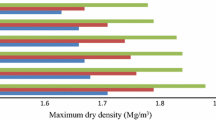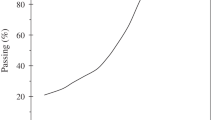Abstract.
This study evaluates the potential use of cement-kiln dust (CKD), a waste product from the cement industry, for enhancing the mechanical as well as the hydraulic properties of soils in arid lands. Stabilized products will play a major role in reducing slope failures, pavement damage and the design of containment barriers for hazardous waste in arid lands. Various tests to determine the different physical properties of the stabilized matrix were conducted and the optimum mixture that produces maximum internal energy and minimum hydraulic conductivity was selected. The effect of soaking and unsoaking of the treated specimens on the mechanical properties was also evaluated. The effect of metal ion concentration and conjugate anions on the resultant hydraulic conductivity was evaluated. The optimum percentage of CKD was calculated by using stress–strain data, Newton's divided difference and Simpson's integration technique. The analyses have shown that 6% by weight of CKD is the optimum mix design, which increases the shear strength and decreases the hydraulic conductivity to less than 10–9 m/s. Therefore, the treated soil could be used as a soil-based barrier layer for containment of hazardous waste.
Similar content being viewed by others
Author information
Authors and Affiliations
Additional information
Electronic Publication
Rights and permissions
About this article
Cite this article
Mohamed, .A. Hydro-mechanical evaluation of soil stabilized with cement-kiln dust in arid lands. Env Geol 42, 910–921 (2002). https://doi.org/10.1007/s00254-002-0590-3
Received:
Accepted:
Issue Date:
DOI: https://doi.org/10.1007/s00254-002-0590-3




